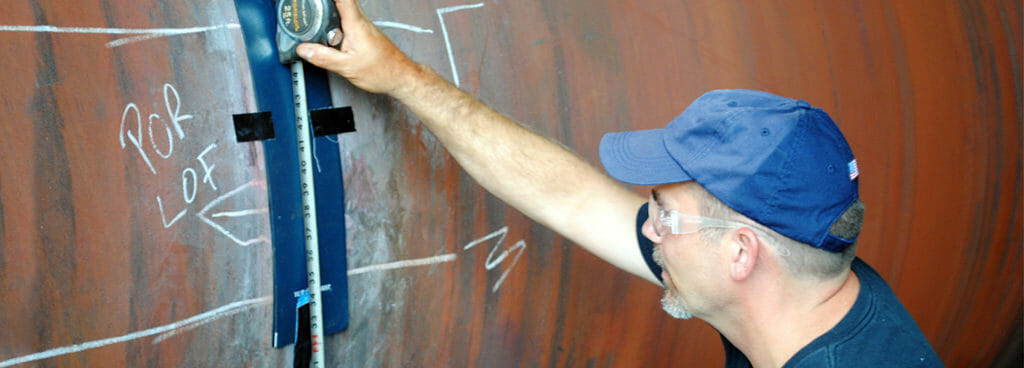- Home
- Special Services
MARINE SERVICES
construction
other services
weld services
- NDT Services
methods
additional services
- About Us
- Locations

Importance of Inspecting Industrial Assets
International Inspection performs comprehensive NDT inspections to determine the health of clients’ industrial assets. Large assets — structures, equipment, vessels, etc. — inevitably deteriorate over time due to a variety of factors. Manufacturing and fabricating are precise but ultimately imperfect processes, as sometimes parts go into service that bear flaws such as voids, cracks, porosity, etc. Furthermore, using an asset outside of the service conditions specified in its design document (such as the maximum allowable working pressure (MAWP) for a pressure vessel) can result in permanent damage and hazardous working conditions. Yet, even when produced correctly and used precisely as intended in its design specifications, the asset’s base materials undergo a range of agents that threaten to compromise its overall effectiveness and structural integrity; factors including corrosion, cyclical stresses, environmental weathering, vibrations, and the like cause incremental breakdown over time that can lead to complete, costly failure.
While failure may be inevitable, the service life of a structure, vessel, or machine can be extended significantly through minor repairs and preventive maintenance, which allow companies to get more work out of their assets before retiring or replacing them. The way that companies determine when, where, and how to perform maintenance or repairs on a given industrial asset is by inspecting it. However, self-led assessments can provide a false sense of security; inexperienced inspectors can miss indications that would signal impending trouble to formally trained and certified inspectors. While well-versed in visually identifying problem areas, certified inspectors use more advanced methods to detect issues imperceptible to the naked eye. International Inspection’s ASNT-certified inspectors perform comprehensive inspections to systematically examine and definitively verify the condition of an industrial asset.
Our NDT Inspection Capabilities
We conduct these inspections using several methods that fall under the umbrella of nondestructive testing (NDT). This branch of examination encompasses exactly what the name implies: techniques that do not harm the subject of analysis. By implementing these methods, our inspectors can detect causes for concern without necessarily taking the subject out of service or damaging its components. Below are some of the ways that our certified inspectors assess the health of industrial equipment, large machines, structures, vessels, and other assets:
Method | Applications | Used to Find | Performed Using |
|---|---|---|---|
Preliminary method of assessment in every NDT inspection | Visible flaws, indications: i.e., corrosion, evidence of leaks, etc. | Eyes; handheld and specialized cameras | |
Piping inspections; weld inspections; component assessments | Surface defects in non-porous materials, imperceptible by VT: cracks, fractures, etc. | Penetrant (can be water- or solvent-removable; pink/red or fluorescent) and developing agent | |
Flaw detection in components such as bolts and impellers; boiler and piping inspections | At- and near-surface defects in ferromagnetic materials imperceptible by VT: cracks, cupping, laminations, etc. | Yoke, prod, or coil; ferromagnetic particles suspended in wet solution or dry powder | |
Locating subsurface defects; determining corrosion loss; characterizing bond strength | Laminations, seams, porosity, hydrogen flakes, several types of cracks, material / coating thickness | Transducer; pulser/receiver; display device | |
Detecting defects; imaging subsurface elements in concrete | Voids, porosity, cold laps, slag inclusions, cracks | Emitter; detector; iridium-192; darkroom | |
Determining material / equipment compliance, verifying design spec compliance, ensure proper welding filler material | Material composition of ferrous/nonferrous metals; identify alloys | Niton XL2 Gold PMI Unit | |
Detect ferrous subsurface elements in soil or concrete | Rebar, conduits, PT cables, utility lines, etc. | Transmitter; receiver; computer | |
Assess viability of welded elements / weldment repairs | Defects of all sorts: cracks, slag inclusions, incomplete fusion, incomplete penetration, etc.; metal composition | Above methods: VT, PT, MT, UT, RT, PMI |
By setting a regular, ASNT-recommended inspection schedule, clients can catch gradual issues before they have time to develop into significant problems. If your company needs the services of a certified NDT inspections provider, contact International Inspection today.
